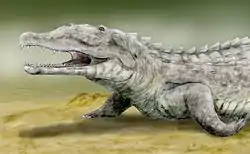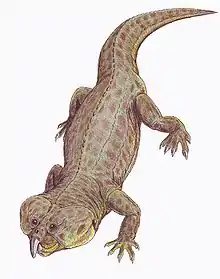Smilosuchus
Smilosuchus (meaning "chisel crocodile") is an extinct genus of leptosuchomorph phytosaurid from the Late Triassic of North America. The type species was first described in 1995 as a replacement generic name for Leptosuchus gregorii.[1] Because of the large rostral crest it possessed, it was considered to be distinct enough from other species of Leptosuchus (all of which had smaller and more restricted crests) to be within its own genus. Some studies seem to suggest that Smilosuchus is congeneric with Leptosuchus, as the enlarged crest could have been independently developed in Leptosuchus.[2] However, newer studies support the idea that Smilosuchus is distinct from the type species of Leptosuchus, Leptosuchus crosbiensis. Phylogenetic analyses suggest that Smilosuchus is more closely related to pseudopalatines than to Leptosuchus species.[3][4]
| Smilosuchus Temporal range: Late Triassic | |
|---|---|
 | |
| Skull of Smilosuchus gregorii | |
| Scientific classification | |
| Kingdom: | Animalia |
| Phylum: | Chordata |
| Class: | Reptilia |
| Order: | †Phytosauria |
| Family: | †Phytosauridae |
| Node: | †Leptosuchomorpha |
| Genus: | †Smilosuchus Long & Murry, 1995 |
| Type species | |
| †Smilosuchus gregorii (Camp, 1930) | |
| Species | |
| |


Features
Like all phytosaurs, Smilosuchus had the nostrils close to the top of its head. The rostral crest and nasal bulge supporting these raised nostrils was larger in Smilosuchus than in many other phytosaurs. Its skull was extremely large, up to 155 cm long, although estimates for the overall length vary from 7 to 12 metres. The jaws are very short and broad and the teeth are heterodont, with large tusks at the anterior of the mouth for impaling prey and more blade-like teeth for slicing flesh closer to the back of the mouth. The tusks are mounted on a bulge at the tip of the snout present in nearly all phytosaurs. Its squamosal processes are short and deep, indicating a powerful bite. This coupled with its large size (it is one of the largest known phytosaurs) suggests that it hunted large prey such as Placerias.[5]
Phylogeny
Below is a cladogram from Stocker (2012):[4]
| Phytosauria |
| |||||||||||||||||||||||||||||||||||||||||||||||||||||||||||||||||||||||||||||||||||||||||||||
List of synonyms

Synonyms of S. adamanensis:
Machaeroprosopus adamanensis Camp, 1930
Rutiodon adamanensis (Gregory, 1962)
Leptosuchus adamanensis (Long & Murry, 1995)
Synonyms of S. gregorii:
Machaeroprosopus gregorii Camp, 1930
Phytosaurus gregorii (Gregory, 1962)
Nicrosaurus gregorii (Gregory, 1962)
Rutiodon gregorii (Ballew 1989)
Leptosuchus gregorii (Irmis, 2005)
Synonyms of S. lithodendrorum:
Machaeroprosopus lithodendrorum Camp, 1930
Rutiodon adamanensis (Gregory, 1962)
References
- Long, R. A., and Murry, P. A. (1995). Late Triassic (Carnian and Norian) tetrapods from the southwestern United States. New Mexico Museum of Natural History and Science Bulletin 4:1-254.
- Irmis, R. B. (2005). The vertebrate fauna of the Upper Triassic Chinle Formation in Northern Arizona. In: Nesbitt, S. J., Parker, W. G. and Irmis, R. B., eds., Guidebook to the Triassic Formations of the Colorado Plateau in northern Arizona: Geology, Paleontology, and History. Mesa Southwest Museum, Bulletin No. 9.
- Michelle R. Stocker (2010). "A new taxon of phytosaur (Archosauria: Pseudosuchia) from the Late Triassic (Norian) Sonsela Member (Chinle Formation) in Arizona, and a critical reevaluation of Leptosuchus Case, 1922". Palaeontology. 53 (5): 997–1022. doi:10.1111/j.1475-4983.2010.00983.x.CS1 maint: uses authors parameter (link)
- Stocker, M. R. (2012). "A new phytosaur (Archosauriformes, Phytosauria) from the Lot's Wife beds (Sonsela Member) within the Chinle Formation (Upper Triassic) of Petrified Forest National Park, Arizona". Journal of Vertebrate Paleontology. 32 (3): 573–586. doi:10.1080/02724634.2012.649815.
- "Palaeos Vertebrates: Archosauria: Phytosauridae". palaeos.com. Retrieved 2018-05-13.






